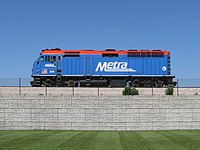
Photo from wikipedia
To achieve benefits similar to those seen in hybrid-/all-electric ground-based and marine vehicles, electric propulsion has been proposed for large commercial aircraft. Among the main drivers of this are improved… Click to show full abstract
To achieve benefits similar to those seen in hybrid-/all-electric ground-based and marine vehicles, electric propulsion has been proposed for large commercial aircraft. Among the main drivers of this are improved fuel economy, reduced harmful emissions, and lower audible noise. In converting to electric propulsion, the added electrical components' masses must be minimised so that the benefits that the components enable - improved turbine efficiency, distributed propulsion and propulsion-airframe integration - are not cancelled out by their weight penalty. This puts stringent requirements on the large electric machines used in the system, both those that generate electric power from the turbine shaft and those that drive propellers or ducted fans, because they are among the heaviest of the added electric components. A key machine design metric in this application is the specific power (SP), or the power-to-mass ratio. This study gives a comprehensive overview of large electric machines for aircraft electric propulsion applications, with a focus on methods for mass reduction and SP improvement.
Journal Title: Iet Electric Power Applications
Year Published: 2018
Link to full text (if available)
Share on Social Media: Sign Up to like & get
recommendations!